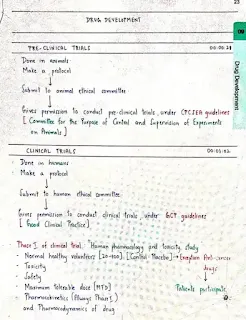Drug Development Notes: Downloadable PDF
Download comprehensive notes on the drug development process in PDF format. These notes cover the entire journey of a new drug, from initial discovery and preclinical testing to clinical trials (Phase 1, 2, 3, and 4), regulatory review and approval (e.g., by the FDA in the US), and post-marketing surveillance. Learn about the key steps, challenges, and regulatory requirements involved in bringing a new drug to market. Ideal for students, researchers, and professionals in the pharmaceutical and biotechnology industries. Download now for convenient offline access.
Keywords: Drug Development, PDF, Download, Notes, Preclinical Testing, Clinical Trials, FDA Approval, Drug Discovery, IND, NDA, Pharmacology, Pharmaceutical Development, Phase 1, Phase 2, Phase 3, Phase 4, Regulatory Affairs, Good Manufacturing Practice (GMP), Good Laboratory Practice (GLP), Good Clinical Practice (GCP), Pharmacokinetics, Pharmacodynamics, Safety, Efficacy.
The Drug Development Process: From Discovery to Market
Developing a new drug is a complex, time-consuming, and expensive process that typically takes 10-15 years and costs billions of dollars. It involves multiple stages, from initial research and discovery to preclinical testing, clinical trials, regulatory review, and post-market surveillance. This document provides an overview of the drug development process.
1. Drug Discovery and Target Identification
The process begins with identifying a medical need and a potential drug target. A drug target is typically a molecule (e.g., a protein, receptor, enzyme, or gene) that plays a key role in a disease process. Researchers may use various approaches to identify and validate potential drug targets, including:
- Basic Research: Understanding the underlying biology of the disease.
- Genomics and Proteomics: Identifying genes and proteins that are involved in the disease.
- Bioinformatics: Using computational tools to analyze large datasets and identify potential targets.
- High-Throughput Screening: Testing large libraries of chemical compounds to identify those that interact with the target.
Once a promising target is identified, researchers search for a "lead compound" – a molecule that shows activity against the target in laboratory tests.
2. Preclinical Development
Before a potential drug can be tested in humans, it undergoes extensive preclinical testing to evaluate its safety and efficacy. Preclinical studies are conducted *in vitro* (in test tubes or cell cultures) and *in vivo* (in animals). Key aspects of preclinical development include:
- Pharmacology: Studying the drug's mechanism of action, how it interacts with the target, and its effects on the body.
- Pharmacokinetics (PK): Studying the absorption, distribution, metabolism, and excretion (ADME) of the drug. How the body processes the drug.
- Pharmacodynamics (PD): Studying the relationship between drug concentration and its effects. What drug does on body.
- Toxicology: Assessing the potential toxicity of the drug. This includes short-term and long-term studies in animals to identify any adverse effects.
- Formulation: Developing a suitable formulation of the drug (e.g., tablet, capsule, injection) for administration.
- Manufacturing: Developing a process to manufacture the drug on a larger scale, following Good Manufacturing Practice (GMP) guidelines.
If the preclinical studies demonstrate that the drug is reasonably safe and shows potential efficacy, the drug sponsor can submit an Investigational New Drug (IND) application to the regulatory authority (e.g., the Food and Drug Administration (FDA) in the United States).
3. Clinical Trials
Clinical trials are conducted in humans to evaluate the safety and efficacy of the investigational drug. They are typically divided into three phases:
- Phase 1: Focuses on safety. The drug is tested in a small group of healthy volunteers (typically 20-80) to determine its safety, tolerability, dosage range, and pharmacokinetic properties.
- Phase 2: Focuses on efficacy and further evaluates safety. The drug is tested in a larger group of patients with the target disease (typically 100-300) to assess its effectiveness and identify any short-term side effects.
- Phase 3: Confirms efficacy, monitors side effects, and compares the drug to standard treatments. These are large-scale, randomized, controlled trials involving hundreds or thousands of patients with the target disease. Data from Phase 3 trials are the primary basis for regulatory approval.
Clinical trials are conducted under strict ethical guidelines and regulations, including Good Clinical Practice (GCP). Informed consent is obtained from all participants.
4. Regulatory Review and Approval
If the clinical trials demonstrate that the drug is safe and effective, the drug sponsor can submit a New Drug Application (NDA) to the regulatory authority (or a Biologics License Application (BLA) for biological products). The NDA contains all the data from preclinical and clinical studies, as well as information on manufacturing and labeling.
The regulatory authority reviews the NDA to determine whether the drug is safe and effective for its intended use. This review process can take several months or even years. If the regulatory authority approves the NDA, the drug can be marketed and sold.
5. Post-Market Surveillance (Phase 4)
Even after a drug is approved, it continues to be monitored for safety and efficacy through post-market surveillance (Phase 4 studies). This involves collecting and analyzing data on adverse events and long-term effects of the drug. If new safety concerns arise, the regulatory authority may take action, such as adding warnings to the drug label or, in rare cases, withdrawing the drug from the market.
Drug development is a high-risk endeavor. Many potential drugs fail during the development process, either due to safety concerns or lack of efficacy. The rigorous testing and regulatory review process is designed to ensure that only safe and effective drugs reach patients.
Info!
If you are the copyright owner of this document and want to report it, please visit the copyright infringement notice page to submit a report.

